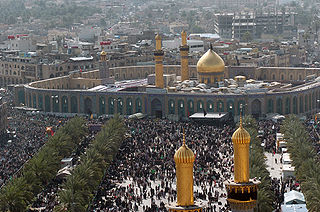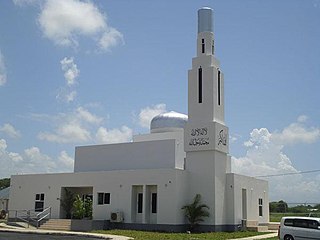The music of Trinidad and Tobago is best known for its calypso music, soca music, chutney music, and steelpan. Calypso's internationally noted performances in the 1950s from native artists such as Lord Melody, Lord Kitchener and Mighty Sparrow. The art form was most popularised at that time by Harry Belafonte. Along with folk songs and African- and Indian-based classical forms, cross-cultural interactions have produced other indigenous forms of music including soca, rapso, parang, chutney, and other derivative and fusion styles. There are also local communities which practice and experiment with international classical and pop music, often fusing them with local steelpan instruments.

Muḥarram is the first month of the Islamic calendar, and one of the four sacred months of the year when warfare is banned. The tenth of Muharram is known as Ashura, an important day of commemoration in Islam. For Sunni Muslims, the day marks the parting of the Red Sea by Moses and the salvation of the Israelites, celebrated through supererogatory fasting and other acceptable expressions of joy. By contrast, Ashura is a day of mourning for Shia Muslims, who annually commemorate the death of Husayn ibn Ali, grandson of the Islamic prophet Muhammad and the third Shia imam. Husayn was killed, alongside most of his relatives and his small retinue, in the Battle of Karbala in 680 CE against the army of the Umayyad caliph Yazid ibn Mu'awiya. The Shia rituals span the first ten days of Muharram, culminating on Ashura with mourning processions in Shia cities. Also in Muharram, the Aqsa mosque in Jerusalem was initially set as the direction of prayer for early Muslims.

Ashura is a day of commemoration in Islam. It occurs annually on the tenth of Muharram, the first month of the Islamic calendar. For Sunni Muslims, Ashura marks the parting of the Red Sea by Moses and the salvation of the Israelites. Also on this day, Noah disembarked from the Ark, God forgave Adam, and Joseph was released from prison, among various other auspicious events on Ashura in Sunni tradition. Ashura is celebrated in Sunni Islam through supererogatory fasting and other acceptable expressions of joy. In some Sunni communities, the annual Ashura festivities include carnivals, bonfires, and special dishes, even though some Sunni scholars have criticized such practices.

Indian Arrival Day is a holiday celebrated on various days in the nations of the Caribbean, Fiji, South Africa and Mauritius, commemorating the arrival of people from the Indian subcontinent to their respective nations as indentured labours brought by European colonial authorities and their agents. In Guyana, Mauritius, Fiji and Trinidad and Tobago, where it started, it is an official public holiday.
Indo-Caribbeans or Indian-Caribbeans are people in the Caribbean who are descendants of the Jahaji indentured laborers from India and the wider subcontinent, who were brought by the British, Dutch, and French during the colonial era from the mid-19th century to the early 20th century. A minority of them are descendants from people who immigrated as entrepreneurs, businesspeople, merchants, engineers, doctors, religious leaders and other professional occupations beginning in the mid-20th century.

Indo-Trinidadians and Tobagonians or Indian-Trinidadians and Tobagonians are people of Indian origin who are nationals of Trinidad and Tobago, whose ancestors came from India and the wider subcontinent beginning in 1845 during the period of colonization.

Emancipation Day is observed in many former European colonies in the Caribbean and areas of the United States on various dates to commemorate the emancipation of slaves of African descent.

In Shia Islam, Arba'in marks forty days after Ashura, which is the death anniversary of Husayn ibn Ali, grandson of the Islamic prophet Muhammad and the third Shia imam. Husayn was killed, alongside most of his relatives and his small retinue, in the Battle of Karbala on 10 Muharram 61 AH against the army of the Umayyad caliph Yazid ibn Mu'awiya. The battle followed Husayn's refusal to pledge his allegiance to Yazid, who is often portrayed by Muslim historians as impious and immoral. In Shia Islam, Karbala symbolizes the eternal struggle between good and evil, the pinnacle of self-sacrifice, and the ultimate sabotage of Muhammad's prophetic mission.
The culture of Trinidad and Tobago reflects the influence of Indian-South Asian, African, Indigenous, European, Chinese, North American, Latino, and Arab cultures. The histories of Trinidad and Tobago are different. There are differences in the cultural influences which have shaped each island. Trinidad and Tobago is an English-speaking country with strong links to the United Kingdom.

Hinduism in Trinidad and Tobago is the second largest religion. Hindu culture arrived to Trinidad and Tobago in 1845, with the arrival of the first Indian indentured laborers, the overwhelming majority of which were Hindu. According to the 2011 census there were 240,100 declared Hindus in Trinidad and Tobago.

In Trinidad and Tobago, Jamaica, and other parts of the Caribbean, the term tassa refers to a drumming ensemble drawn from an amalgamation of various North Indian folk drumming traditions, most importantly dhol-tasha, a style that remains popular today in many parts of India and Pakistan. Beginning in the 1830s and lasting until 1918, dhol-tasha was taken around the world by Indian workers, mostly from present-day Bihar and Uttar Pradesh, enmeshed in a global scheme of indentured labor in British, French, and Dutch territories.

Muslims constitute 5.6 percent of the population of Trinidad and Tobago. The majority live in Trinidad but there are a handful in Tobago as well.

Jamaica is a predominantly Christian country, with Islam being a minority religion. Due to the secular nature of Jamaica's constitution, Muslims are free to proselytize and build places of worship in the country.
The Hosay massacre took place on 30 October 1884 in San Fernando, Trinidad when the British colonial authorities fired on participants in the annual Hosay procession who had been banned from entering the town.

Ta'zieh means comfort, condolence, or expression of grief. It comes from the roots aza which mean mourning. It commonly refers to passion plays about the Battle of Karbala and its prior and subsequent events. Sir Lewis Pelly began the preface of his book about Ta'ziyeh maintaining that "If the success of a drama is to be measured by the effects which it produces upon the people for whom it is composed, or upon the audiences before whom it is represented, no play has ever surpassed the tragedy known in the Mussulman world as that of Hasan and Husain." Years later Peter Chelkowski, professor of Iranian and Islamic studies at NYU, chose the same words for the beginning of his book Ta`ziyeh, Ritual and Drama in Iran.

The mourning of Muharram is a set of religious rituals observed predominantly by Shia Muslims, largely during the month of Muharram, the first month of the Islamic calendar. These annual rituals commemorate the death of Husayn ibn Ali, grandson of the Islamic prophet Muhammad and the third Shia imam. Husayn and his small retinue were slaughtered in the Battle of Karbala on 10 Muharram 61 AH against the army of the Umayyad caliph Yazid ibn Mu'awiya. The battle followed Husayn's refusal to pledge his allegiance to Yazid, who is often portrayed by Muslim historians as impious and immoral. In Shia Islam, Karbala symbolizes the eternal struggle between good and evil, the pinnacle of self-sacrifice, and the ultimate sabotage of Muhammad's prophetic mission. Historically, the event served to crystallize the Shia community into a distinct sect and remains an integral part of their religious identity to date.
Shia Islam in Africa is the continent's second most widely professed sect of Islam behind Sunni Islam.

Rozeh Khani or Rawda khwani is the Shia Iranian Muslim ritual of the Mourning of Muharram. It is held every day of the year to commemorate the death of Husayn ibn Ali and his followers during the Battle of Karbala.
Mahmoud Pharouk Alladin (1919–1980) was a Trinidad and Tobago artist, poet, writer, teacher and public servant. Alladin played a major role in the expansion of art education and was an important influence on a wide range of Trinidad and Tobago artists. He helped develop a local artistic identity, and helped legitimise rural Indo-Trinidadian life as a subject for local artists.














